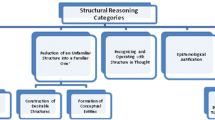Abstract
Through our work in mathematics and science education we have observed that students react similarly to a wide variety of conceptually unrelated situations. Our work suggests that many responses which the literature describes as alternative conceptions could be interpreted as evolving from common, intuitive rules. This paper describes and discusses one such rule, manifested when two systems are equal with respect to a certain quantity A but differ in another quantity B. We found that in such situations, students often argue that ‘Same amount of A implies same amount of B’. Our claim is that such responses are specific instances of the intuitive rule ‘Same A—same B’. This approach explains common sources for students'; conceptions and has strong predictive power.
Similar content being viewed by others
References
Cough, E.E. and Driver, R.: 1986, 'A study of consistency in the use of students' conceptual frameworks across different task contexts', Science Education 70(4), 473–496.
Dembo, Y., Levin, I. and Siegler, R.S.: 1997, 'A comparison of the geometric reasoning of students attending Israeli ultraorthodox and rain stream schools', Developmental Psychology 33(1), 92–103.
Erickson, G.L.: 1979, 'Children's conceptions of heat and temperature', Science Education 63(2), 221–230.
Fischbein, E.: 1987, Intuition in science and mathematics: An educational approach, D. Reidel, Dordrecht, The Netherlands.
Fischbein, E. and Schnarch, D.: 1997, 'The evolution with age of probabilistic, intuitively based misconceptions', Journal for Research in Mathematics Education 28(1), 96–105.
Hirstein, J.: 1981, 'The second area assessment in mathematics: Area and volume', Mathematics Teacher 74, 704–708.
Hoffer, A.R. and Hoffer, S.A.K.: 1992, 'Geometry and visual thinking', in T.R. Post, (ed.), Teaching Mathematics in Grades K-8: Research-Based Methods (2nd ed.), Allyn and Bacon, Boston.
Linchevsky, L.: 1985, 'The meaning attributed by elementary school teachers to terms they use in teaching mathematics and geometry', Unpublished doctoral dissertation, Hebrew University, Jerusalem, Israel (in Hebrew).
Livne, T.: 1996, 'Examination of high school students' difficulties in understanding the change in surface area, volume and surface area/ volume ratio with the change in size and/or shape of a body', Unpublished Master's thesis, Tel-Aviv University, Tel Aviv, Israel (in Hebrew).
Meged, H.: 1978, 'The development of the concept of density among children ages 6–16'. Unpublished Master's thesis, Tel-Aviv University, Tel Aviv, Israel (in Hebrew).
Noelting, G.: 1980a, 'The development of proportional reasoning and the ratio concept: Part I — differentiation of stages', Educational Studies in Mathematics 11, 217–253.
Noelting, G.: 1980b, 'The development of proportional reasoning and the ratio concept: Part II — problem structure at successive stages: problem solving strategies and the mechanism of adaptive restructuring', Educational Studies in Mathematics 11, 331–363.
Noss, R.: 1987, 'Children's learning of geometrical concepts through LOGO', Journal for Research in Mathematics Education 18(3), 343–362.
Nunes, T., Schliemann, A.D. and Carraher, D.W.: 1993, Street Mathematics and School Mathematics, Cambridge University Press, Cambridge.
Piaget, J. and Inhelder, B.: 1974, The Child's Construction of Quantities, Routledge & K. Paul, London.
Piaget, J., Inhelder, B. and Szeminska, A.: 1960, The Child's Conception of Geometry, Routledge & K. Paul, London.
Rojhany, L.: 1997, 'The use of the intuitive rule 'The more of A, the more of B': The case of comparison angles', Unpublished Master's thesis, Tel Aviv University, Tel Aviv, Israel (in Hebrew).
Ronen, E.: 1996, 'Overgeneralization of conservation', Unpublished Master's thesis, Tel Aviv University, Tel Aviv, Israel (in Hebrew).
Schrage, G.L.: 1983, '(Mis-)interpretation of stochastic models', in R. Scholz (ed.), Decision Making Under Uncertainty, North-Holland, Amsterdam, pp. 351–361.
Shultz, T., Dover, A. and Amsel, E.: 1979, 'The logical and empirical bases of conservation judgments', Cognition 7, 99–123.
Stavy, R. and Berkovitz, B.: 1980, 'Cognitive conflict as a basis for teaching quantitative aspects of the concept of temperature', Science Education 64, 679–692.
Stavy, R., Strauss, S., Orpaz, N. and Carmi, C.: 1982, 'U-shaped behavioral growth in ratio comparisons, or that's funny I would not have thought you were u-ish', in S. Strauss with R. Stavy (eds.), U-Shaped Behavioral Growth, Academic Press, New York, pp. 11–36.
Stavy, R. and Tirosh, D.: 1996, 'Intuitive rules in mathematics and science: The case of 'The more of A — the more of B', International Journal of Science Education 18(6), 653–667.
Strauss, S. and Stavy, R.: 1982, 'U-shaped behavioral growth: Implications for theories of development, in W.W. Hartup (ed.), Review of Child Development Research, University of Chicago Press, Chicago, pp. 547–599.
Tirosh, D.: 'Inconsistencies in students' mathematical constructs', Focus on Learning Problems in Mathematics 12(1), 111–129.
Tirosh, D. and Stavy, R.: 1996, 'Intuitive rules in science and mathematics: The case of 'Everything can be divided by two',' International Journal of Science Education 18(6), 669–683.
Tversky, A. and Kahneman, D.: 1983, 'Extensional versus intuitive reasoning: The conjunction fallacy in probability judgment, Psychological Review 90, 293–315.
Walter, N.: 1970, 'A common misconception about area', Arithmetic Teacher 17, 286–289.
Wiser, M. and Carey, S.: 1983, 'When heat and temperature were one', in D. Gentner and A.L. Stevens (eds.), Mental Models, Lawrence Erlbaum, Hillsdale, New Jersey, pp. 267–296.
Woodward, E. and Byrd, F.: 1983, 'Area: Included topic, neglected concept', School Science and Mathematics 83, 343–347.
Author information
Authors and Affiliations
Rights and permissions
About this article
Cite this article
Tirosh, D., Stavy, R. Intuitive rules: A way to explain and predict students' reasoning. Educational Studies in Mathematics 38, 51–66 (1999). https://doi.org/10.1023/A:1003436313032
Issue Date:
DOI: https://doi.org/10.1023/A:1003436313032




